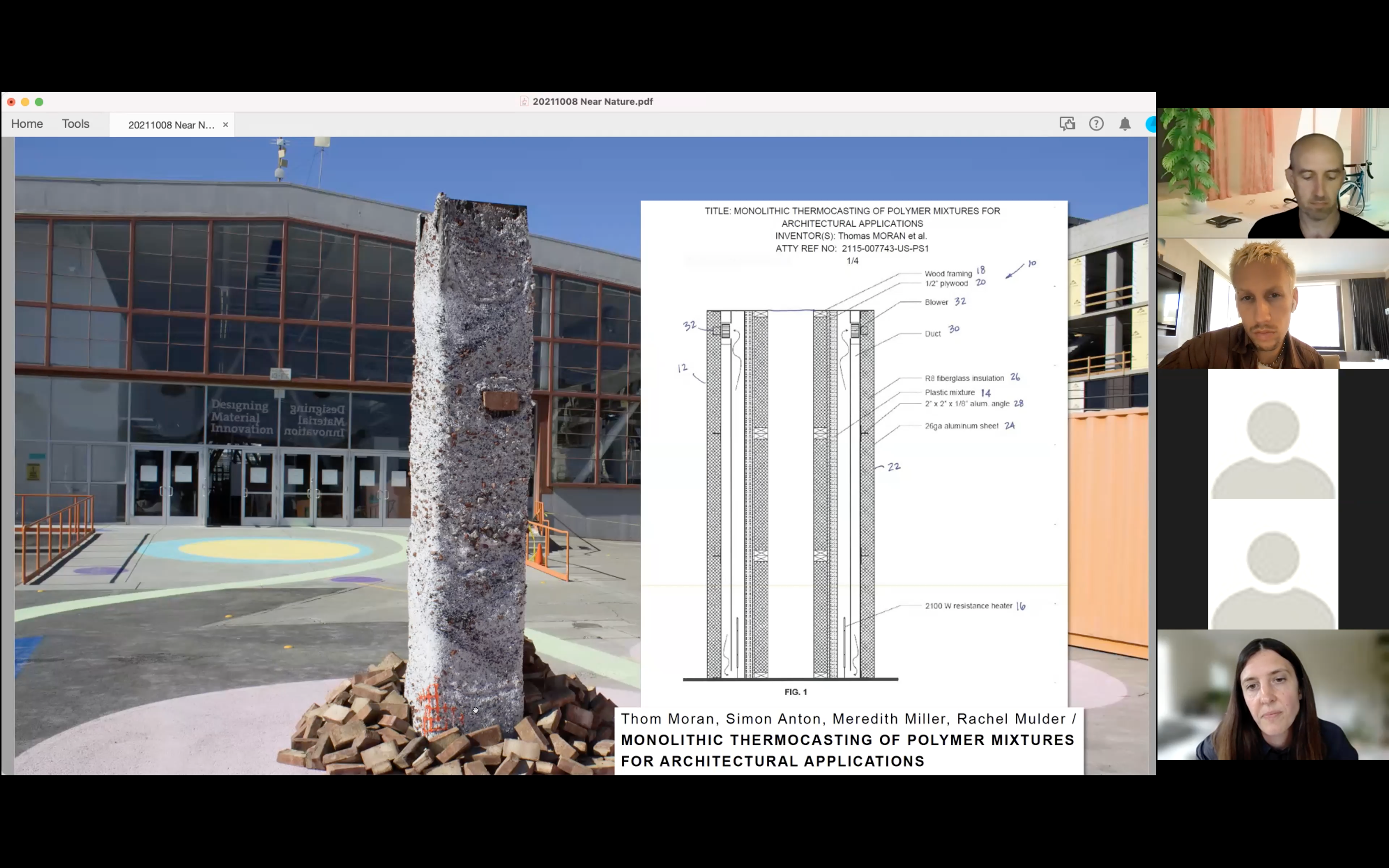Material Acts
Material Acts is a presentation and discussion series with design practitioners organized to advance the topics of the exhibition. The discussion series examines how contemporary design practices (specifically in architecture) mobilize, confound, and generate natures, from simulating mechanics to growing biological matter. The conversations are organized around processes, attending to specific actions or activities enacted upon materials to induce their change. Rather than, say, consider concrete as a plastic yet static form, we might treat it instead as a series of logistical operations, of transport, mixing and curing, as well as a junction of energy flows. By engaging action over object, verbs over nouns, the framework allows us to understand materials as process-based events, rather than artifacts in stasis, re-centering the human actor or agent in the event, reminding us that materials are not natural.
A series of 75-min discussions were organized around thematic gerunds, or actions transformed into nouns, including weaving, feeding, aggregating, laminating, etc.
Material Acts 1: Aggregating

The first half of the session focuses on the processes of aggregating. Historically, aggregate materials result from a process of breaking down one material into smaller components, and then recomposing those materials with a second, such as glue, cement, or another binding agent. While aggregating has typically incorporated geologically decomposed materials (sand and gravel), this session invites practices who have incorporated non-naturally occurring materials (such as plastic) and reclaimed materials (construction waste) into the processes of aggregation. The second half of the session furthers this inquiry into recycling or circular economies by inviting practices who question the need to bind aggregate material, instead exploring methods of jamming or piling.
Participants
Meredith Miller (she/her) is an architect and Associate Professor at the University of Michigan, Taubman College of Architecture and Urban Planning. Her research and practice links architecture’s materiality to global resources, climate change, and post-natural ecologies. She is a founding member of T+E+A+M.
Anton Maertens (he/him) is Business Developer at BC materials. He studied City Development & Renovation Coordination in Brussels and has worked as a (sustainability) advisor for the Flemish & Brussels Government. BC materials is winner of the Pioneer Award of the Belgian Building Awards & Henry Vandevelde Award - Climate Challenge 2020.
Petrus Aejmelaeus-Lindström (he/him) is an architect and researcher at Gramazio Kohler Research (GKR) at ETH Zurich. In his current research, Petrus is developing innovative robotic fabrication techniques for in situ fabrication of fully reversible structures from locally sourced materials.
Garrett Ricciardi (he/him) is a lecturer at UCLA and co-founder of Formlessfinder, an interdisciplinary practice for design, research, and writing. The practice operates as a laboratory for methodological experimentation oriented toward the introduction of moments of formlessness into architecture.
Material Acts 2: Animating

Focused on processes of animating, this session invites practices that embed responsive materials within assemblies, in order to induce changes in surface porosity, visual transparency, and/or structural composition. In some cases transformation is induced electro-mechanically—actuators activate changes through electrical signals. Other projects heighten the physical-chemical responses of specific materials to environmental inputs such as heat and changes in temperature. In many cases, the practice of animating materials also requires designing a choreographed sequence of inputs and outputs that echoes a homeostatic model of nature.
Participants
Doris Sung is Associate Professor of Architecture at the University of Southern California and founder of DOSU Studio Architecture. Through grant-funded research, she is developing smart materials, such as thermobimetals, to self-ventilate, self-shade, self-structure, self-assemble and self-propel in response to changes in temperatures–all with zero-energy and no controls.
Omar Khan is Professor and Head of the School of Architecture at Carnegie Mellon University. Khan’s research and creative activities span architecture, installation/performance art, and digital design and fabrication.
Felecia Davis is an Associate Professor at the Stuckeman Center for Design Computing in the School of Architecture and Landscape Architecture at Pennsylvania State University and is the director of SOFTLAB@PSU. This lab is dedicated to developing soft computational materials and textiles.
Material Acts 3: Growing

Focused on processes of growing, this session invites practices that incorporate living matter into material fabrication, to enhance structural or environmental performance or open new pathways for form-making. In some cases this occurs through directing the labor of organisms and harvesting the organic output of this labor, to be combined with inanimate materials. In other scenarios, populations of organisms are embedded directly into material systems, as structure or processor. Across these various approaches, the engagement with living non-human agents recenters attention on the practices of care necessarily involved in sustaining liveness, such as acts of growing and feeding.
Participants
Christine Yogiaman is Assistant Professor of Architecture and Sustainable Design at the Singapore University of Technology and Design, where she leads the Dynamic Assemblies Lab with Kenneth Tracy. She directs Yogiaman Tracy Design (yo_cy), a research and design practice that focuses on the utilization of digital techniques along with contextual influences to create culturally embedded, affective work in Indonesia.
Ferdinand Ludwig is Professor of Green Technologies in Landscape Architecture at the Technical University of Munich. He is also the co-founder of ludwig.schönle, a collaborative office focusing on design strategies to integrate Baubotanik concepts in architecture and urban planning.